IDEX Online Research: Polished Diamond Prices Soften Modestly in October
November 03, 08
October may have been one of the worst months in the history of the global stock markets, but for the diamond industry, it continued to remain an oasis of tranquility in a sea of turmoil. Globally, polished diamond prices were down just 1 percent from September, based on the IDEX Online Polished Diamond Price Index.
Most of the decline came among larger stones – above two carat – where trading volume has slackened notably. Prices for smaller stones – two carat and below – held reasonably steady on a month-to-month basis, though prices for one-half carat stones fell more than some of the other smaller sizes.
Here’s what appears to be going on:
- Demand for large stones – four-carat and above – has moderated as consumers who would normally buy those stones are either out of the market or have stepped down to smaller size diamonds, perhaps in the three-carat range.
- Demand for one-half carat stones, which are the heart of the mass market, has softened considerably as those consumers have stayed out of the malls and cut back on discretionary expenditures.
What kept the diamond trading markets insulated and stabilized from the tumultuous activity in the other commodity and stock markets? The polished diamond trading bourses are still closed markets – “outsiders” have traditionally not been invited to participate. Because diamond traders – often from a long line of family members – have been in the business so long, they have been through many cycles, and they tend to remain relatively calm, even under the most adverse circumstances. They understand the market and the product. They have a sense of responsibility to maintain an orderly market, even if demand and supply are out of balance. So-called stock and commodities trading specialists on other exchanges could take lessons from diamond traders.
While polished diamond prices appear to have held more or less stable, both September and October were challenging months for polished diamond dealers. Trading activity slowed, especially among stones in the three-to-five carat range. Dealers did not want to drop their prices for these larger stones, as reflected by continued relatively high “asked” prices on the IDEX Online polished diamond trading platform. However, rather than take lower prices, most dealers chose to hold onto their larger, better quality stones; they anticipate that in a year or so, prices will firm up.
On the other hand, we did see some limited selling that appeared to be driven by fear and panic. That’s unhealthy for the market, though this was probably driven by banks tightening credit limits and demanding repayment of outstanding loans.
Because diamond demand traditionally correlates with economic cycles, it is highly likely that diamond trading activity will continue to slow. Diamond prices have risen substantially over the past two years, and it is time for the markets to consolidate and stabilize – that’s a natural cycle. While it is possible that diamond prices could become volatile similar to other commodities, it is unlikely because of the nature of the polished diamond trading markets.
The best advice: sit tight, don’t panic (like the traders in the financial markets), and wait for this economic cycle to stabilize. Remember, the tide comes in, and the tide goes out. And it always comes back in.
Two-Year Diamond Price Acceleration Continues to Slow in October
The graph below summarizes the IDEX Online Polished Diamond Price Index for the past 24 months. This graph represents the composite average prices of all diamonds traded at the wholesale level. The slope of the line steepened in the first half of the year, reflecting consistently higher prices – and a greater rate of price inflation – for virtually all diamond sizes. However, since June, polished diamond price inflation has paused, as the red line illustrates.
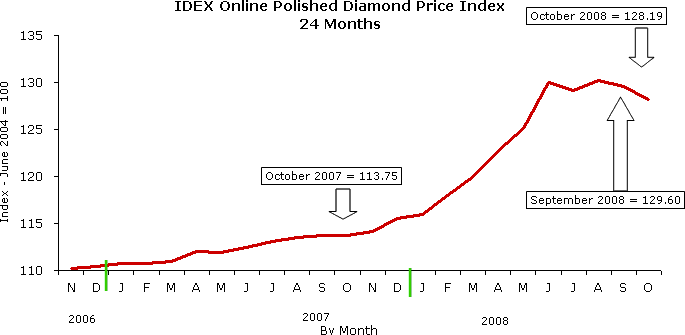 Source: IDEX Online Research |
 |
The graph below summarizes month-to-month changes in global diamond prices for the past thirteen months. Beginning in February 2008, polished diamond prices showed large gains during every month in the first half of the year.
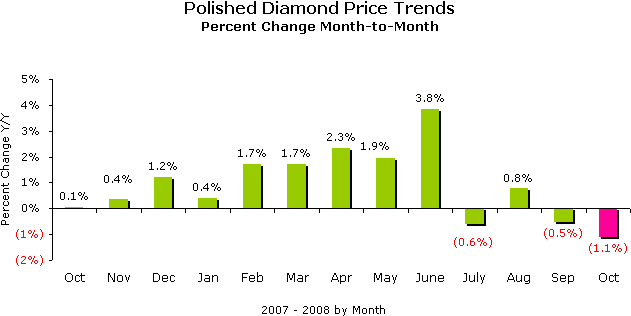 Source: IDEX Online |
October 2008 versus October 2007: +12.7 percent 
Even though October’s year-over-year inflation rate continued to show moderation, it is unreasonable to believe that this annualized level of diamond price inflation – nearly +13 percent – is sustainable, even though rough diamond prices have risen by about 16 percent or so this year. However, most other commodities have risen sharply in price over the past several years. As we have said many times, the polished diamond industry remains too fragmented for anyone – or any group – to hold pricing power similar to the tight-knit community of rough diamond suppliers.
The graph below summarizes the year-over-year inflation rate by month for polished diamond prices in the global market for the past thirteen months.
Comparisons are based on the daily average prices during the month versus the same month a year ago. The year-to-year comparison takes into account the seasonality of polished diamond demand and prices.
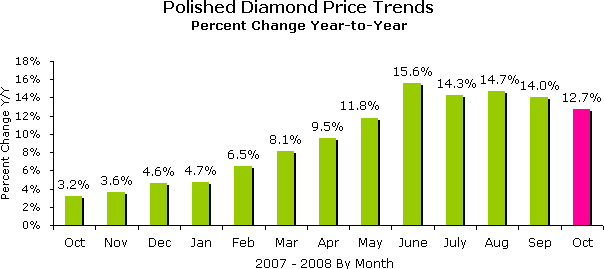
Source: IDEX Online
Daily Polished Prices Drifted Lower During the Month
Polished diamond prices drifted lower in October, with a sharp drop near the end of the month. After accelerating for the first half of 2008, polished diamond prices stabilized in June, and have drifted slightly lower since then. This coincides with the slide of global financial markets as investors and merchants became worried about the possibility of a worldwide recession. Diamond traders found that they were unable to buy and sell diamonds at the artificially high prices reflected on some industry price lists; thus, overall asking prices declined slightly to more realistic levels. Still, there was no panic similar to that which characterized the global financial markets.
The following graph illustrates the average price of polished diamonds on a day-by-day basis for the three-month period August-October 2008. While there was some modest polished diamond price volatility early in October, prices stabilized – softening slightly – during the second half of the month, with a relatively sharp price decline late in the month.
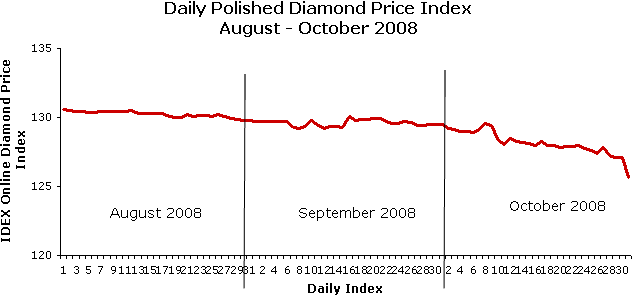
Source: IDEX Online
Month-to-Month Diamond Prices Decline for Most Sizes
After stabilizing for several months, month-to-month polished diamond prices have shown some decline for almost all of the key sizes. While demand had been strong for large diamonds – in the 4-5 carat range – retailers are now seeing some shopper reticence as consumers buy “down.”
Rather than buying the largest, fanciest stone, shoppers are willing to compromise on either quality or size. According to retailers, shoppers are opting for stones that are more modest though flashy. Thus, prices for these larger stones have shown a greater decline than some of the other key sizes over the past month.
The graph below summarizes the price changes for key sizes of polished diamonds on a month-over-month basis: October 2008 versus September 2008. These seven stone sizes represent about 33 percent of the trading market by value.
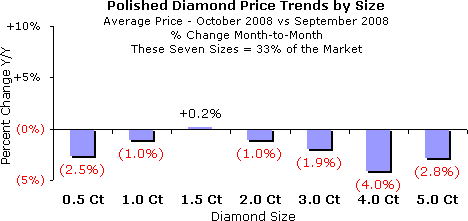
Source: IDEX Online
Year-Over-Year Diamond Prices for All Sizes Continue to Show Decelerating Double-Digit Price Inflation
On a year-to-year comparison, polished diamond prices continued to rise at double-digit levels for all but the smallest stones one-half carat and below. As has been the trend for this diamond demand cycle (about 3-4 years), prices for large stones in the three-to-five carat range showed a much higher inflation rate than prices for stones two-carat and smaller stones. However, it is important to note that the year-over-year price inflation rate for polished diamonds is decelerating.
The graph below summarizes polished diamond prices by key sizes on October 2008 versus October 2007 basis. These seven sizes represent about one-third of the market, by aggregate value.
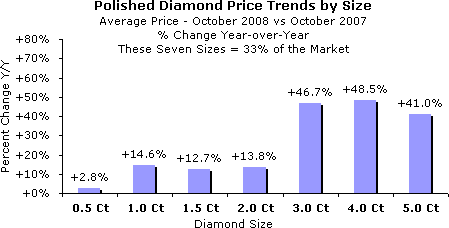
Source: IDEX Online
Long Term Diamond Price Inflation Concentrated in Large Stones
Based on the IDEX Online Polished Diamond Price Index, polished diamond demand for quality stones three carats and higher has been much greater over the long term than demand for smaller stones in the range of two carats and below.
The graph below summarizes the long term price inflation trend for the past two years for the seven key diamond sizes, based on the IDEX Online Polished Diamond Price Index.
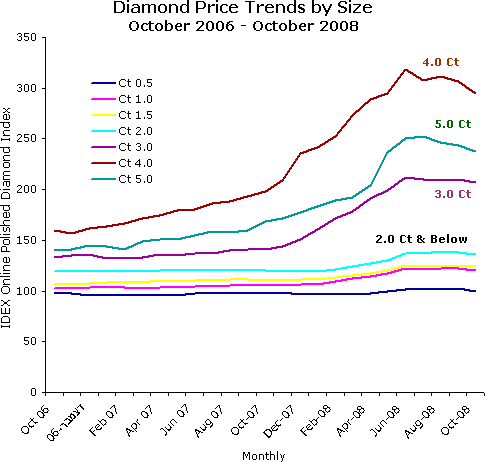
Source: IDEX Online
Forecast: Polished Diamond Prices Likely to Drift Lower Near Term
The inflation flames related to polished diamond price have been snuffed out, in our opinion. While polished diamond prices rose at unrealistic rates in the first half of the year, we do not foresee this trend in the second half of 2008. There is too much uncertainty related to the global economic situation to fuel continued diamond price inflation at the unusually high rates earlier this year.
After a strong first half, economic growth in the U.S. as measured by Gross Domestic Product (GDP) finally slid into slightly negative territory – 0.3 percent down – for the third quarter ended September 30, 2008. Most economists are predicting another quarter, at least, of modestly negative economic growth. The media has whipped consumers and businesses into a frightened frenzy, and put them into a mental recession which could be worse than the numbers indicate.
In an effort to keep the world’s economies from slipping further into recessionary territory, central banks worldwide are pumping money into their economies. This should keep credit markets liquid and help stimulate growth.
Unfortunately, consumers have been particularly hard-hit. Both real estate and stock prices are down; these two categories are typically shoppers’ largest asset categories. When consumers feel less wealthy, they tend to tighten their purse strings.
Oil prices have retreated, so consumers’ pocketbooks won’t be as pinched as we head into the holiday selling season. This could help maintain demand for discretionary goods.
About the IDEX Online Diamond Price Index
The IDEX Online Diamond Price Index is a real-time index derived from actual asking prices in the global diamond industry. The IDEX Online Diamond Price Index objectively reflects price trends as they happen. The Diamond Index and Diamond Drivers were formulated following comprehensive research and analysis of the IDEX Online inventory database, aggregated since 2001. Research and development were conducted in cooperation with Dr. Avi Wohl, Senior Lecturer of Finance at the faculty of Management, Tel Aviv University, Israel.
Additional information is available from IDEX Online Research. The e-mail address is diamondprices [at] idexonline [dot] com.